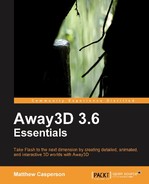All 3D objects are constructed using a number of basic elements: vertices, triangle faces, Sprite3D objects, and segments. These elements are then combined and added to a Mesh object to create more complex shapes, and we saw some example code that demonstrated how this can be done manually.
Texture maps are applied to the surface of a 3D object using UV coordinates, which define how a texture map is displayed by a triangle face.
Away3D includes a number of classes that allow primitive shapes like cubes, cones, spheres, and planes to be easily created without having to manually construct them from their basic elements. A sample application was presented that demonstrated how these primitive 3D objects can be created and added to the scene. The differences between similar primitives, like the sphere and geodesic sphere, were highlighted.
We also touched on some additional topics that will be covered in more detail in later chapters. The cube and skybox classes have some unique ways of applying materials, and the sphere classes showed some significant differences in the way they applied materials. For these classes, we used the BitmapFileMaterial class, which will be covered in more detail in Chapter 5, Materials.
The sample application also made use of the rotationX, rotationY, and rotationZ properties from the Object3D class to modify the orientation of the primitive 3D objects. These parameters are explored in the next chapter, in which we will learn how to move, rotate, and scale 3D objects within the scene.
